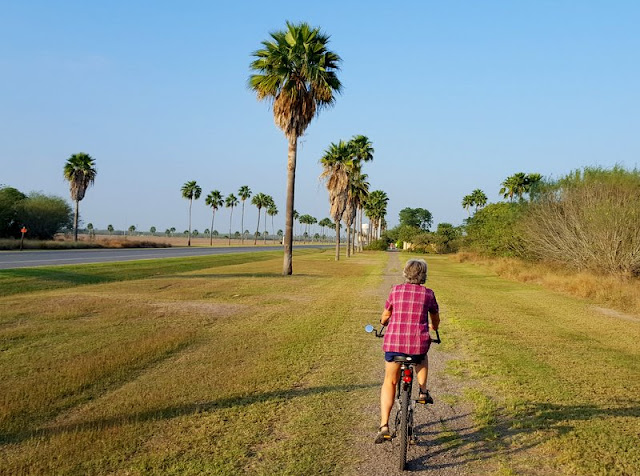Just four miles down the road from our campground is one of the best birding locations in the country--the Bentsen-Rio Grande World Birding Center. We have visited here many times in the past, and using our Texas state park pass, we went back again this year. It's an easy bike ride to get to the state park on a beautiful January afternoon.
There is an education center at the park, where we learned that 80% of all birds migrate south for the winter. Many of them will make their way through this park, flying over the narrow neck of land heading toward central and South America. We pedaled the loop around the park, filled with mesquite trees, and a few retama trees. This area was completely flooded in 2010 when the Rio Grande River went out of its banks. Because there was water standing in the park for months, many of the mesquite trees, and all of the cactus that were indigenous to this area were killed. Neither mesquite nor cactus like standing in water!
There are actually three cactuses left in the park, and we challenge you to find one of them in the picture below.
Any logical person would be scanning the ground for those cactus. But we'll zoom in to show a close-up of one of the surviving prickly pear cactus plants. It's in the top branch of the tree in the picture above. It was probably deposited as a seed in the form of bird poop. That resourceful cactus managed to latch on to the tree trunk to develop roots that were far above the flood waters.
There are several bird blinds in the park. We parked our bikes to spend some time in one of the adjustable blinds that allows observer to use the proper height openings to best view the birds at the feeder.
We saw a few colorful birds during our visit, including this cardinal with bad table manners. He was eating with his mouth open when we took his picture.
This is a green jay, one of the most colorful birds. Denisa thinks it is easy to confuse the green jays with the flocks of green parrots we often see overhead. The wild parrots are easy to spot because they squawk loudly as they fly. But the parrots seem to stay high in the palm trees, far away from our camera lens. So we appreciated this green jay, who stays closer to the ground.
We also got a fuzzy picture of two birds bathing in the water feature. The Great Kiskadee is showing off the yellow breast that makes him easy to spot among the trees.
The chachalaca are less colorful, but one of the larger birds at the park. About the size of a chicken, they have grown accustomed to the humans in the park and will let people get close. "Chachalaca" is a fun word to say when we see this chocolate-colored bird.
We wish we had a picture of the resident bob cat, but he has eluded us on our trips to the state park. We talked with another couple that had great pictures of the cat when he crossed the road right in front of them.
Besides riding bikes, another way to see this state park is via the trams that circle the roads every hour. Our favorite tram ride is at 2:00, when the park ranger drives and gives entertaining comments throughout the tour.
We took Denisa's Mother on one of these tram rides, that offer just enough walking for an 86-year-old to appreciate. So even though we prefer riding our bikes through the World Birding Center, we enjoyed this option that will work for other travelers.
Ranger Amber also told about the history of this park that lies along the border of Mexico. Before the days of GPS computer mapping, concrete markers were used to mark national boundaries. It wouldn't work to have this survey marker in the middle of the Rio Grande River, as rivers tend to change their course over time. So there are actually two markers--this one in the United States, and another one three miles away in Mexico. The official border is exactly halfway between the two markers. So at this point we are exactly 1.5 miles away from the official U.S./Mexico border.
We have found that the population of this part of the Rio Grande Valley has really exploded in the thirty years that Denisa's Mother has been wintering here. The quaint little towns have grown together into one large city along a very busy expressway. This metropolitan atmosphere means that every type of restaurant and big box store imaginable is close-by. But we really enjoy this little chunk of natural Texas in our backyard that is so easy to visit!












No comments:
Post a Comment